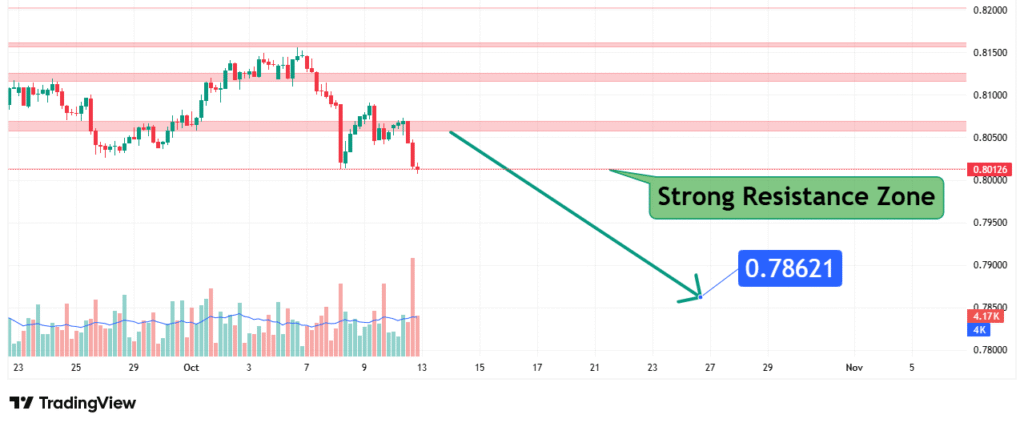
NZDCAD Price Analysis Bearish Breakdown Targets 0.786
NZDCAD’s price has been consolidating and facing repeated rejection at a strong resistance zone between approximately 0.815 and 0.820. This price action suggests a bearish bias is forming. Our analysis projects a sustained move downwards towards a primary target of 0.786. This prediction is based on a confluence of technical factors, primarily the strength of the historical resistance zone and the price’s inability to break higher despite multiple tests.
Current Market Structure and Price Action
The broader market structure for NZDCAD is bearish, characterized by a series of lower highs since the peak in late October. The price is currently interacting with a well-defined and strong resistance zone. Recent price action has shown clear signs of seller dominance near this zone, with long upper wicks and failure to close above it, indicating that a bearish breakdown is the most probable next move.
Identification of the Key Resistance Zone
The most critical technical element is the Strong Resistance Zone around 0.815 – 0.820. The strength of this zone is derived from:
- Historical Significance: This level has acted as a major swing high and consolidation area on multiple occasions throughout October and early November, as clearly marked on the provided chart. Each touch has resulted in a sell-off.
- Technical Confluence: The zone aligns with the 0.786 Fibonacci retracement level (0.78621), a powerful level often used by institutional traders, adding significant weight to its importance.
- Market Psychology: This area represents a point where buyers have repeatedly failed to push the price higher, leading to exhaustion. Sellers are actively defending this level, creating a ceiling for the pair.
This multi-touch confluence makes it a high-probability level for a bearish reaction.
Technical Target and Rationale
Our analysis identifies the following price target:
- Primary Target (PT1): 0.786
- Rationale: This level represents a key psychological round number and a significant support area from mid-September. A move to this target would represent a full retracement of the late-October bounce and a test of a prior equilibrium zone.

Prediction: We forecast that the price will be rejected from the current resistance zone and accelerate a decline towards our primary target at 0.786.
Risk Management Considerations
A professional strategy is defined by its risk management.
- Invalidation Level (Stop-Loss): The entire bearish thesis is invalidated if the price achieves a decisive daily close above the resistance zone at 0.8220. This level represents a clear break of the established market structure and would signal that buyers have overcome the selling pressure, likely leading to a move higher.
- Position Sizing: Any short positions taken should be sized so that a loss triggered at the 0.8220 invalidation level represents a small, pre-defined percentage of your total capital (e.g., 1-2%).
Fundamental Backdrop
The technical setup is framed by the current fundamental landscape:
- Commodity Correlation: Both the NZD and CAD are commodity-linked currencies. The outlook for dairy (key for NZD) and oil (key for CAD) will be a primary driver. Recent weakness in oil prices could provide some support for NZDCAD, but the technical resistance appears to be overpowering this factor for now.
- Central Bank Policies: The monetary policy outlook from the Reserve Bank of New Zealand (RBNZ) and the Bank of Canada (BoC) is crucial. Any hawkish shifts from the BoC relative to the RBNZ would add fundamental fuel to this technical bearish setup.
Conclusion
NZDCAD is at a technical inflection point, pressed against a formidable resistance zone. The weight of evidence, based on price action and technical confluence, suggests a bearish resolution, targeting a move down to 0.786. Traders should monitor for a confirmed breakdown below the recent lows and manage risk diligently by respecting the key invalidation level above 0.8220. The reaction at the 0.786 target zone will be crucial for determining whether the bearish trend will extend further or stage a consolidation.
Chart Source: TradingView
Disclaimer: This analysis is for informational and educational purposes only and does not constitute financial advice or a recommendation to buy or sell any security. All trading and investing involves significant risk, including the possible loss of your entire investment. Always conduct your own research (DYOR) and consider seeking advice from an independent financial professional before making any trading decisions.






